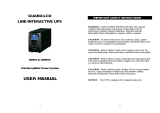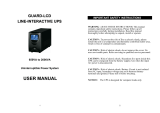Page is loading ...

UPS
Emergency Backup Power Supply For Use With Computer Loads Only
Intelligent Auto-Shutdown SoftwarePower Surge/Noise Protection
Internet Line Protection
Cost Efficiency
AVR Protection
Compact & Reliable Design
USER'S MANUAL
1st Edition, 2018
Uninterruptible Power System
701-0071299 UPS-7730BR-NLCD-01

TROUBLE SHOOTING
If the UPS does not operate properly, please
follow below steps to check and fix
problem firstly. If the problem remains, please consult
sales agent or authorized
distributor for service.
Is the main power switched on?
Is the UPS plugged into a working outlet correctly?
Is the line voltage within the rating specified?
Is the AC breaker on the rear panel blown or damaged?
Is the UPS over loaded?
Is battery not fully charged? Dead battery? Charger failure?
Please provide the following information when call for service.
1. Model number, serial number.
2. Date of the problem occurred, date of purchase.
3.
Full description of the problem including load, LCD, alarm status, installation
condition, and working environment, etc.
Trouble-Shooting Chart
Problem Possible Cause Solution
UPS is not
turned on, LCD
is not lighted,
and no alarm.
Switch on front panel is in “Off”
position.
Press “Power On/Off”
button to turn
on UPS.
Breaker on rear panel is damaged. Replace breaker and restart UPS.
Power cord is loose.
Check if input power cord is
plugged into wall outlet tightly.
UPS stays at
battery mode
always.
Power cord is loose.
Check if input power cord is
plugged into wall outlet tightly.
Breaker on rear panel is damaged.
Replace breaker and restart UPS.
If problem remains, call for service.
Backup time is
shorter than
rated.
Batteries are not fully charged
Recharge batteries for at least 6
hours and then test backup time
again. If problem remains, call for
service.
- 10 -
IMPORTANT SAFETY INSTRUCTIONS
Thank you for selecting this uninterruptible power system (UPS).
It provides emergency backup power and overall protections for your
important devices upon utility outages.
Please read this manual
!
This manual provides safety, installation and operating instructions which will
guide you to the best performance of the UPS.
Please save this manual
!
It
includes important instructions for the safe usage of the UPS and to obtain
manufacturer’s support in case of need.
Please save or recycle the packaging materials
!
Packaging materials used in
this UPS are designed to provide protection from
transportation
. These materials are necessary in case that the UPS needs
to be sent or shipped back for service
. Damage that may occur during
transportation and/or shipment is not covered by the UPS’s warranty.

CONTENTS
PAGE
1. CAUTION…………………………………………………………..…..1
2. INTRODUCTION
SYSTEM DESCRIPTION………………………….……………..2
FEATURES………………………………….….…………………..2
3. SYSTEM CONCEPT
BLOCK DIAGRAM……………………………….………………..3
NORMAL OPERATION………………………….………………..3
AC UTILITY FAILURE………………………….…………………4
4. OVERVIEW
FRONT PANEL……………………………………………………5
REAR PANEL……………………………………………………6
5. INSTALLATION AND OPERATION…………………………………7
6. BATTERY FACTS……………………………………………………8
7. SPECIFICATIONS……………………………………………………9
8. TROUBLE SHOOTING………………………………...……………10
SPECIFICATIONS
Capacity 2000VA 3000VA
Input
Voltage
110/115/120VAC or 220/230/240VAC
±25%
Frequency
50Hz or 60Hz ±5%
Output
Voltage
(Batt. Mode)
110/115/120VAC or 220/230/240VAC
±5%
Frequency
50Hz or 60Hz +/- 1Hz
Waveform
Modified sine wave
Transfer Time
Less than 6ms (typical)
Battery
Battery Type
12V/7AH*4PCS 12V/9AH*4PCS
Recharge Time
5 hours to 90% after complete discharge
Status
Indicator
LCD
Input and output voltage, AC normal, Load level,
Battery level, Overload, Fault
Alarm
Battery Back-up
Sounding every 3 seconds
Battery Low
Sounding every 1 second
Overload
Continuous beeping sound
Protection
Overload
Fuse & current limited
Short Circuit
Fuse & current limited & Cut off
Batt. Low Cut-off
No battery drain after cut-off
Physical Dimension
530mm*19”*2U (D*W*H)
Environment
Temperature
Humidity
32℉-104℉ at full load,
0~95% relative humidity (non-condensing)
Noise Level
Less than 40db at 1 meter
Interface
Smart USB
communication
port
Shutdown software supporting
Windows 95/98/NT/2000/ME/XP/2003/Vista/7/8/10
- 9 -

BATTERY FACTS
The battery is the only periodically serviceable parts in the UPS. Expected life
for batteries is about 3-5 years. However, frequently
long discharges or ambient
temperatures over 80°F will reduce battery life.
Therefore, it is recommended to
replace the batteries every 3 years after initiating the unit.
Recharge batteries every 3 months is necessary if it is not in use because it may
cause batteries over-drain.
WARNING
Only a qualified technician should replace the battery.
Batteries have high
short-circuit current capacity; mistakes upon
connecting or disconnecting
can cause connections to arc or weld, and furthermore
could cause severe
burns.
STORAGE
The UPS should only be stored if the battery is fully charged. Avoid storage
temperatures over 80°F as battery
life is significantly shortened. Every 90 days
remove the unit from storage and plug it in for 24 hours to recharge the batteries.
Batteries may be damaged if there are left in storage and not recharged
every 90
days.
IMPORTANT NOTICE
Please use same type and same rating of batteries for replacement.
Do not replace it with the battery that exceeds specified rating.
- 8 –
CAUTION
The UPS contains voltages
that are potentially hazardous. All repairs
should be performed by qualified service personal.
The UPS has its own internal energy source (battery). The output
receptacles may be active even when the UPS is not connected to an
AC
power supply.
The UPS is suitable for computers and electronic equipment with
substantially rectifier or capacitive loads, not suitable for electronic
equipment with significant inductive loads, such as motors & fluorescent
lamps.
Be sure to operate within the power rating of the UPS.
Below 1/2 or 1/3
of rated power is recommended for longer backup time and battery life.
Do not place the UPS near excessive humidity, under sunshine, or close
to heat-emitting sources.
If the UPS is out of order, plea
se detach power cord and consult your
dealer right away.
Do not remove cover if there is no serviceable part
inside.
The unit should be supplied by grounded source.
Do not operate the
unit without grounded source.
The socket-outlet should be installed
near the equipment and be easily
accessible.
Do not plug the UPS power cord into itself.
That will result in a safety
hazard.
Installation should be performed by a qualified technician or electrician in
accordance with local electrical codes.
- 1–

INTRODUCTION
System Description:
The product is line interactive UPS with comprehensive LCD display, advanced
technology and outstanding function. The line interactive UPS is made
with
voltage stabilizer. It accepts input voltage range +/-
25%, but output voltage
regulation is +/- 5% due to its embedded voltage stabilizer.
The line interactive UPS provides emergency backup powe
r as well as overall
protections for your important devices in home or office upon utility outages.
Features:
Line interactive design
Rack / tower convertible design
User friendly comprehensive LCD display
Equipped with boost and buck AVR to stabilize utility voltage
Constant current, constant voltage (CCCV) battery charger and battery over
drain protection
Over/under voltage protection (UPS goes to battery mode)
UPS charges itself even though power switch is off (Off-mode charging)
Built-in DC start function enables UPS to be started without AC power
supplied (dip switch set up)
No-load auto shutdown (dip switch set up)
Buzzer alarm auto-reset (dip switch set up)
Auto-restart when AC recovery
Lightning / surge protection 175 joules
Modem / phone / fax / internet line protection RJ-45
Management software is designed to monitor and control UPS status
USB communication port and cable for managing function via PC
- 2 –
INSTALLATION AND OPERATION
Installation:
Upon receipt of the UPS, inspect the shipping carton for damage.
If there is
any obvious damage, immediately report it to the selling dealer or the
delivering carrier. If no damaged is noticed, unpack the unit and then
inspect
the unit for damage.
The UPS should be installed
in a protected environment with temperature
ranged from 32°F to 104°F and relative humidity 0∼95
% without condensation.
Do not block inlets and outlets. Install the UPS in a location where is away
from excessive dust and chemical fumes.
Check the identification label to verify the UPS voltage and power rating
to
match the specified line voltage and load requirements.
Operation:
1. Check if “Power On/Off” button on UPS front panel is in “Off” p
osition and
then make sure that the voltage of AC utility corresponds to the voltage
specified on sticker pasted on UPS. If no problem, plug UPS
input
power cord into grounded wall outlet.
2. When UPS is connected to AC utility, LCD is lighted and shows “UPS
OFF”. This UPS is made with “Off-mode charging”
, so UPS
automatically starts to charge itself after it is connected to AC power even
though UPS is not turned on.
3. Press “Power On/Off” button and “Normal”
icon on LCD will light on for 2
seconds. The UPS is then ready and starts to work normally.
4. Connect your PC with UPS and then turn on PC. Check “Load level”
on
LCD and be sure not to load UPS over 100% (To operate with load less
than 80% is recommended). To simulate AC failure, simply press “
UPS
Test” button on front panel. It helps
to insure whether UPS is in good
condition or not. Alarm beeps every 3 seconds and “Battery”
icon lights
on when UPS is at battery mode. If “Fault”
icon lights on, it means that
UPS in abnormal condition. Then you have to call for service.
5. When battery approaches low level, alarm beeps
every second until
automatic shutdown.
6. UPS will shut down automatically under either of below conditions.
(1)Battery low (2)Short circuit (3)Overload (4) UPS fault
- 7 –

Rear Panel:
German/UK*2PCS + IEC*4PCS:
Nema5-15R*8pcs:
1. Backup/AVR outlets
2. AC input power cord
3. AC breaker
4. Modem / phone / fax / internet line protection port
5. Communication Interface Port:
This port combines relay contact and RS-
232 signal (Optional) on DB9
connector.
6. Dip switch for UPS function setting
7. USB communication port
8. Surge protected outlets
9. External battery connector
- 6 –
SYSTEM CONCEPT
T
he purpose to present this chapter is to give you more precise conception
about how UPS works..
1. Block Diagram
AVR.
INV.
CHA.
N.F. N.F.
INPUT
OUTPUT
Fig. 1 : how UPS works.
2. Normal Operation
There are two main loops when AC utility is normal - the AC output
loop and
the battery charging loop. The AC output gets power from AC utility input and
pass through AVR to support power to load. In the same time, the AC utility
input is converted by AC/DC CHA and support charging power to charge
batteries.
AVR.
INV.
CHA.
N.F. N.F.
INPUT
OUTPUT
Fig. 2 : how the UPS works when AC Utility is normal.
- 3 -

3. AC Utility Failure
If AC utility fails, the UPS quickly detects the problem and activates the inverter.
The DC/AC inverter changes DC power from the batteries into AC and provides
continuous uninterruptible power to load.
AVR.
INV.
CHA.
N.F. N.F.
INPUT
OUTPUT
Fig. 3 : how the UPS works when AC Utility Failure
.
- 4 –
OVERVIEW
Front Panel:
1. Power On/Off Button: Turn on and turn off the UPS.
2. UPS Test Button:
When UPS is working on AC mode, it also activates
the UPS’s self-test by press this button.
3. LCD display:
No.
Indication
Description
4
Input Voltage
Indicate input line voltage value.
5
Output Voltage
Indicate output voltage value.
6
Battery Capacity
Estimated battery capacity, the accuracy is
influenced by UPS operation mode and load
level.
7
Battery
AC power is abnormal and UPS is under
back-up mode.
8
Normal
UPS is under normal status.
9
Overload
UPS is overloaded. Buzzer will beep
continuously.
Please remove some load.
10
Fault
UPS is in fault condition.
11
Load Level
The load level, percentage of full load.
-5-

/


